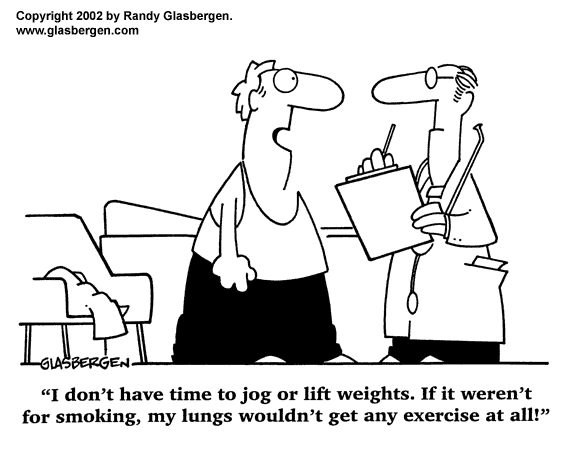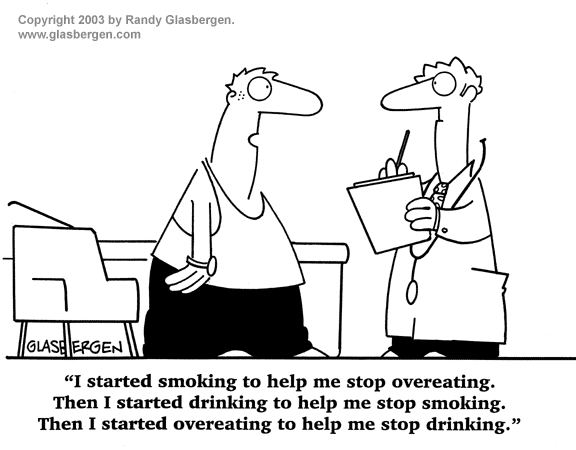Capnomania and Fumimania
Part 4 of 4
England, 1595: The first book in the English language devoted to the subject of tobacco was published.
- The first book in the English language devoted to the subject of tobacco was anonymously published in 1595, by Anthony Chute.
- It had the simple title “Tabacco” and contained an illustration of an Englishman smoking a clay pipe.
- In this little work for laymen, the author earnestly urged smokers not to abuse the kindly weed, upheld its medicinal uses, and suggested that physicians were trying to keep smoking a secret among themselves.
- The reason was, he said, that a moderate use of the pipe was of such value in preserving health that it was likely to make physicians unnecessary!
- From Early Literature of Tobacco by George Arents.
England, 1604: “A Counterblaste to Tobacco”
- “Smoking is a custom loathsome to the eye, hateful to the nose, harmful to the brain, dangerous to the lungs, and in the black, stinking fume thereof nearest resembling the horrible Stygian smoke of the pit that is bottomless.”
- According to James I of England, in his “A Counterblaste to Tobacco.”
- The king reiterated his contempt for those who daily used a drug for pleasure, scorned the acceptance of a habit adopted from unbaptized barbarians [Indians in the Americas], bewailed the cost of what he called this “precious stink”, and repeated some of the tales of horror then used in an attempt to frighten smokers.
- Among other things, he reminded his readers that some great tobacco-takers were found, upon dissection, to have lungs and brains covered by fine, black soot, obviously the result of smoking!
- King James also said if he ever had the Devil to dinner, he’d offer him a pipe.
- As to second-hand smoke, King James said, “The wife must either take up smoking or resolve to live in a perpetual stinking torment.”
- On the other hand, King James’ had the first government to find that taxing tobacco was enormously profitable.
- Since King James’ subjects didn’t accept his advice, he first increased taxes on tobacco four thousand percent, from two pence a pound to six shillings, eight pence a pound.
- That stopped people from buying tobacco, but it also resulted in diminishing the funds that had been coming into the State Treasury.
- Within two years, King James then slashed taxes down to two shillings a pound and so he again received a large income from the sale of the very thing he professed most to dispise.
- Other governments have been quick to learn the same lesson even unto this day.
- The wide advertising smoking received, because of the campaign against it, induced many men and women, who had never smoked before, to take up the custom.
- From George Arents, “Early Literature of Tobacco,” privately printed for distribution at The Library of Congress, 1938.
 Used with special permission from the cartoonist, Randy Glasbergen.
Used with special permission from the cartoonist, Randy Glasbergen.
London, 1847: Philip Morris Opened a Shop and sold hand-rolled Turkish cigarettes.
1880: Twenty-one-year-old Virginian James Albert Bonsack was granted a patent for his cigarette-rolling machine.
- The cigarette market was small then; cigarettes were expensive and hand-rolled by “cigarette girls”.
- Most manufacturers didn’t see any use for a large number of cigarettes.
- The Bonsack machine was seen and rejected by the established cigarette manufacturers.
- In 1883, 27-year-old Buck Duke leased the Bonsack machine.
- By 1887, once Duke and Bonsack’s mechanics had finished tinkering with it, it was capable of reliably rolling 120,000 cigarettes in 10 hours.
- This not only took the cigarette business out of the hands of the cigarette girls, it meant that cigarettes could be made cheaply enough to satisfy a mass market; but the market didn’t exist.
- If he wanted to unload his stockpiling cigarettes, Duke had to create the market, and he used unique and spectacular promotions and advertising campaigns to do it.
- The pressures created by the invention of the Bonsack machine led not only to the widespread use of cigarettes as America’s favored form of tobacco, but to the modern era of mass-market advertising and promotion.
1902-04: Philip Morris Moved to New York
- Tiny British manufacturer Philip Morris, tobacconist to the crown, set up a corporation in New York to sell its British brands, including Philip Morris, Blues, Cambridge, Derby, and one named after the street its London factory was on, Marlborough.
- Marlboro was targeted towards women, and in the 30’s would feature a red tip to hide lipstick marks.
1913: Finally freed from Duke’s American Tobacco Co.,
R.J. Reynolds introduced the Camel cigarette brand.
- The massive, months-long “The Camels are Coming” campaign built anticipation for Camels cigarettes.
- Camel, like Prince Albert before it, consisted of a then-unique blend of three tobaccos: piedmont Bright, a flavored and sweetened burley from Kentucky, and ten percent Turkish leaf.
- The half-price brand (10 cents for 20) was an instant hit, gaining thirty-three percent of the market by 1917, and forty-five percent by 1923.
- Soon after, the American Tobacco Company introduced Lucky Strike and Liggett & Myers introduced Chesterfield, each with similar blends.
- The “modern” cigarette had arrived.
 Used with special permission from the cartoonist, Randy Glasbergen.
Used with special permission from the cartoonist, Randy Glasbergen.
1911: Dr. Charles Pease stated the position of the Non-Smokers’ Protective League of America
- In a letter to the New York Times, dated November 10, 1911, he wrote:
- “The right of each person to breathe and enjoy fresh and pure air—air uncontaminated by unhealthful or disagreeable odors and fumes is a constitutional right, and cannot be taken away by legislatures or courts, much less by individuals pursuing their own thoughtless or selfish indulgence.”
End of Part 4 of 4
 Part 1, if you want it again. Part 1, if you want it again.
|

